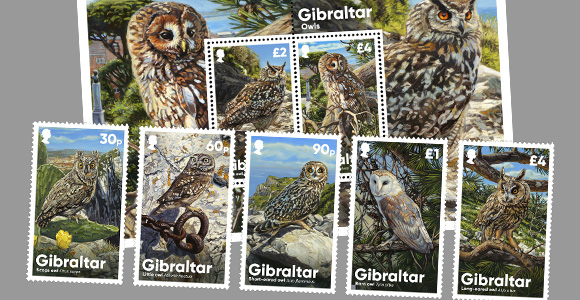Home -> Stamps -> 2020 -> Gibraltar Owls
We also recommend:

Gibraltar Owls (view technical specs)
Owls are birds from the order Strigiformes and are considered to be one of the most iconic bird species. There are over 200 species recorded worldwide, most of which are solitary and nocturnal birds of prey. Seven of these species have been identified in Gibraltar and are depicted on the Stamps
Barn Owl, Tyto alba: A rare migrant past Gibraltar. Occurs occasionally and recorded throughout, including the urban environment. Barn Owls are generally nocturnal, although it is not uncommon to see this species emerge at dusk or be active at dawn, occasionally being seen in flight during full daylight. Flight is noiseless, with wingbeats interrupted by gliding. Barn Owls specialise in hunting small ground mammals, and the vast majority of their food consists of small rodents. They also use low perches such as fence posts to seek quarry.
Little Owl, Athene noctua: Breeds on cliffs around Gibraltar. Europa Point and Europa Advance are typical localities. It can be seen in the daylight, usually perching on a tree branch or rock. It will bob its head up and down when alarmed. In flight it has long, rounded wings, rapid wingbeats and flies with a slight undulation. They feed on small mammals and birds, beetles and worms.
Scops Owl, Otus scops: This tiny owl is a common migrant, observed especially on the Upper Rock. It is a nocturnal bird, most active from after sunset to midnight. Roosts by day in trees, normally close to the trunk, or in dense foliage, cavities in mature trees or rocks, holes in walls and similar places. They feed mainly insects such as grasshoppers, beetles, moths and cicadas. Spiders, caterpillars and earthworms are also taken, as well as small vertebrates such as small mammals, small birds, reptiles and frogs.
Long-eared Owl, Asio otus: A very, very rare migrant past Gibraltar. Recorded on the Upper Rock. It is a medium-sized owl, smaller in size than a woodpigeon. It often looks long and thin, with head feathers (known as ear tufts, even though they are not ears) which it raises when alarmed. It is buff-brown with darker brown streaks and deep orange eyes. They eat small rodents and small birds in winter. They eat small mammals.
Short-eared Owl, Asio flammeus: A rare migrant past Gibraltar. It is most often observed at Windmill Hill Flats, near Europa Point. They are medium sized owls with mottled brownbodies, pale under-wings and yellow eyes. They are commonly seen hunting during the day. They are of European conservation concern and so are an Amber List species.
Tawny Owl, Strix aluco: A few birds spend the winter in Gibraltar, mainly in the gardens of the South District, such as the Alameda. It has a rounded body and head, with a ring of dark feathers around its face surrounding the dark eyes. They eat small mammals and rodents, small birds, frogs, fish, insects and worms.
Eagle Owl, Bubo bubo: A pair tends to breed on the cliffs towards the northern end of the Rock. It is characterized by its large size, often 70 centimetres long, two tufts of feathers on the head (ear tufts), and large orange eyes. The overall coloration is tawny, mottled with brown, lighter below. The eagle owl roosts and breeds within rocky niches and hollow trees. At twilight it perches on a branch while searching its territory for prey, mainly rodents, hares, rabbits, and large game birds.
Technical Specs
| Design: | Stephen Perera |
| Illustration / Photography: | Jon Pointer |
| Printer: | Cartor Security Printers |
| Process: | Offset Lithography |
| Colours: | 4 Colours |
| Stamp size: | 30 x 50mm |
| Issue date: | 2020-09-25 |
| Stamp Values: | 30p, 60p, 90p, £1, £4 (MS) £2, £4 |













